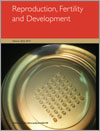Reproduction, Fertility and Development
Volume 26
Number 3 2014
Early embryo loss is one of the main factors affecting reproductive efficiency in cattle and the steroid hormone progesterone plays a major role in establishing uterine receptivity prior to implantation. The aim of this study was to test the effects of administration of human chorionic gonadotrophin (hCG) during the first few days after ovulation on progesterone production by the corpus luteum (CL). Administration of hCG on Day 2 after oestrus increase the size of the original CL and the concentrations of progesterone from Day 6 onwards and may be a useful strategy to promote conceptus development and pregnancy establishment.
The physical environment used in in vitro embryo production has changed little over the years. This study describes a novel polydimethylsiloxane (PDMS) well-insert system that can successfully mature oocytes and culture embryos in an individually-identifiable manner without compromising, and perhaps enhancing, developmental potential in pigs. The application of the PDMS well-insert system to embryo production may allow the development of a more physiological, efficient culture environment; meanwhile, tracking of individual oocytes and embryos becomes feasible.
Changes in maternal bone mass during pregnancy and lactation facilitate calcium transfer to offspring for normal skeletal development. Mothers suffering from uteroplacental insufficiency, which reduces blood flow to the fetus, give birth to offspring who have poor bone health as adults. We have shown that these mothers don’t gain and subsequently lose bone during their pregnancy and lactation, and this reduction in calcium transfer is a likely contributor to the development of poor adult bone health in these offspring.
Cloning miniature pigs using handmade or oocyte bisection cloning techniques in combination with embryo aggregation has provided proof-of-principle for this cost-effective technology in other species. The aim of the present study was to improve cloned embryo development by implementing these two biotechnologies; a beneficial effect on cloning efficiency was shown. The technology in this study is potentially useful in organ transplantation, species conservation and establishing embryonic stem cells for the study of human diseases.
Noninvasive assessment of oocyte quality can be a determining factor in the outcome of assisted reproductive technology cycles. The aim of the present study was to examine associations between the presence of the meiotic spindle and zona pellucida birefringence and the morphology of in vivo-matured and IVM human oocytes. The findings suggest that clinical IVM is a safe technology for enhancing the maturation and integrity of oocytes.
Despite considerable investigations into the pathogenesis of endometriosis, it remains poorly understood. The formation of new vessels (angiogenesis) and inflammatory reactions are known to be crucial for the development of the disease and were investigated in this study in women with endometriosis, before and after danazol treatment. Danazol treatment appears to be highly effective in relieving pain and decreasing CA-125 concentrations. In addition, for the first time we provide the evidence that danazol may stimulate angiogenesis. Implementing an algorithm described in this study would result in the diagnosis of 60% of cases of endometriosis.
At the time of implantation the uterus allows blastocyst implantation; however, at other times of the cycle, it prevents implantation. Mucins are a family of cell-surface proteins that normally impede successful implantation. This study found that mucin 13 may support implantation while mucin 15 may prevent implantation. These new findings in the rat uterus add to the knowledge of factors that promote implantation as well as prevent implantation, which could be useful targets for reproductive technology.
Histone deacetylase inhibitors (HDACis) have been widely used to improve the developmental competence of embryos derived from somatic cell nuclear transfer (SCNT). The present study was conducted to elucidate the effects of valproic acid (VPA), a recently-characterized HDACi, on the early development of bovine SCNT embryos and the underlying mechanisms of these effects. We revealed that VPA enhances the developmental competence of bovine SCNT embryos by alleviating ER stress and its associated developmental damage.
In contrast with other farm animals, only few criteria correlated with developmental competence have been investigated in equine oocytes so far. The aim of the present study was to analyse correlations between zona pellucida birefringence (ZPB) and molecular signatures and developmental competence. Developmentally competent oocytes are larger in size, have higher ZPB values and exhibit a typical genetic signature compared with oocytes of lower quality.
It has long been known that the amount and type of food can influence fertility, but exactly how is unknown. In this study, we asked whether common sugars were used differently by ovarian cells and found that theca cells use glucose and galactose, but not fructose, because they lack a fructose transporter. This study supports the theory that the amount and type of dietary sugar can affect ovarian function, and hence fertility.
Cystic ovaries can be a problem in sows and there are many questions related to cyst formation. In the present study, development of cysts in non-hormonally-treated, lactating sows was studied and the results show that cyst formation is related to insufficient LH pools and disturbed oestradiol feedback, resulting in continued follicle growth. Risk of cyst development can be reduced by not weaning sows too early.
Pretreatment of oocytes with sublethal high hydrostatic pressure (HHP) can improve the developmental competence of cloned embryos, although the underlying molecular mechanism is poorly understood. In the present study, we used DNA microarray-based genome-wide gene expression profiling and found that HHP treatment predominantly accelerated the use of maternal mRNA (mostly involved in embryonic development) in oocytes and activated the expression of imprinting genes, such as DLX5, which benefits development. Our findings suggest that HHP positively affects genomic reprogramming during embryonic development.
Controversy exists in determining the extent of negative impact of varicocele on male fertility and the value of varicocele surgery in correcting infertility. The study aimed to identify predictive factors of successful varicocele surgery for treating male infertility induced by varicocele, and found that age and preoperative sperm density are the predictive factors. Our results may allow clinicians to predict surgical improvement in fertility of male patients with varicocele.




